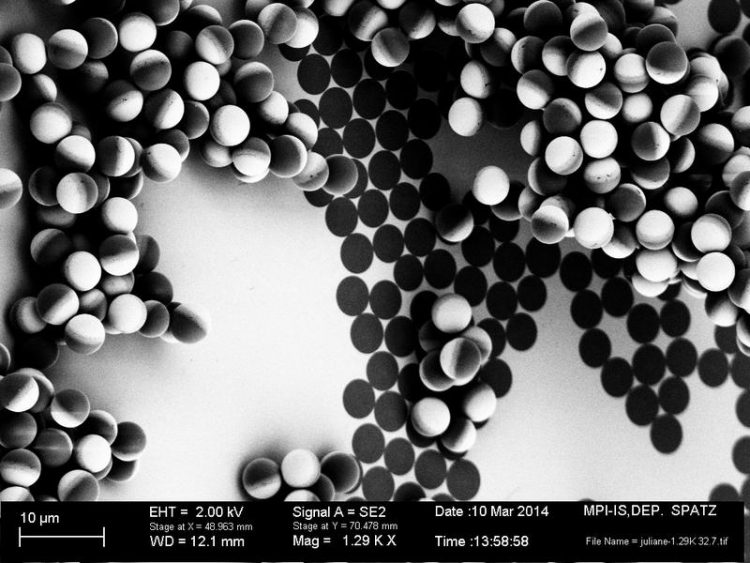Micromotors to open new horizons

Electron microscope image of nanoscale Janus particles, which the Freigeist-group is going to test regarding their capacity as photocatalytic nanomotors. Juliane Simmchen
The team will be researching a new kind of energy input for micromotors – fascinating novel devices bearing great potential for future technology.
A ‘Freigeist’ fellow: for the Volkswagen Foundation this means a young researcher with a strong personality, a creative mind, an ability to identify and use freedom, dedicated to overcoming resistance. Dr. Juliane Simmchen of TU Dresden is one of these extraordinary researchers who wants to overcome existing disciplinary boundaries to gain innovative insights.
During her doctoral thesis in Barcelona/Madrid and as a postdoc at the MPI in Stuttgart, she had been researching catalytic micromotors – a fascinating new field in the movement at the microscale connecting several disciplines of modern science. Micro- and nanomotors are novel devices which can transform energy into movement. Unlike large scale engines dominated by inertia, however, the movement of objects at the microscale requires a constant energy input.
Collaborating with the group of Prof. Eychmüller, Dr. Simmchen now aims at setting a new course in her work. With photocatalytic reactions on the surface of nanoparticles, the Freigeist group wants to research sunlight driven nanomotors. In combining the two innovative fields of photocatalysts and nanomotors, Dr. Simmchen wants to open new horizons for the use of nanomotors driven by renewable energy in several environmental and analytical applications.
So far, micromotors have been chemically or magnetically driven, often under the use of toxic chemicals. Photocatalytic micromotors, however, could be used for environmental remediation. Not only would using a renewable energy source (namely sunlight) drastically improve the general impact for the environment, sunlight driven micromotors would also increase the mixing and catalytic degradation of organic pollutants. Another potential application lies in novel sensors based on the observation of motion of fluorescently labelled molecules or biological markers. This might pave the way for high sensitivity detection and facilitate the mostly complex sample preparation though self-propelled isolation of the species in focus.
Media inquiries:
Dr. Juliane Simmchen
E-Mail: juliane.simmchen@tu-dresden.de
Media Contact
More Information:
http://www.tu-dresden.de/All latest news from the category: Life Sciences and Chemistry
Articles and reports from the Life Sciences and chemistry area deal with applied and basic research into modern biology, chemistry and human medicine.
Valuable information can be found on a range of life sciences fields including bacteriology, biochemistry, bionics, bioinformatics, biophysics, biotechnology, genetics, geobotany, human biology, marine biology, microbiology, molecular biology, cellular biology, zoology, bioinorganic chemistry, microchemistry and environmental chemistry.
Newest articles

NASA: Mystery of life’s handedness deepens
The mystery of why life uses molecules with specific orientations has deepened with a NASA-funded discovery that RNA — a key molecule thought to have potentially held the instructions for…

What are the effects of historic lithium mining on water quality?
Study reveals low levels of common contaminants but high levels of other elements in waters associated with an abandoned lithium mine. Lithium ore and mining waste from a historic lithium…

Quantum-inspired design boosts efficiency of heat-to-electricity conversion
Rice engineers take unconventional route to improving thermophotovoltaic systems. Researchers at Rice University have found a new way to improve a key element of thermophotovoltaic (TPV) systems, which convert heat…



